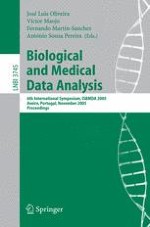2005 | Book
Biological and Medical Data Analysis
6th International Symposium, ISBMDA 2005, Aveiro, Portugal, November 10-11, 2005. Proceedings
Editors: José Luís Oliveira, Víctor Maojo, Fernando Martín-Sánchez, António Sousa Pereira
Publisher: Springer Berlin Heidelberg
Book Series : Lecture Notes in Computer Science
